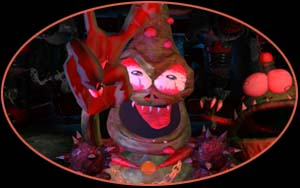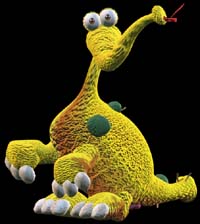

by



Click on image to visit site
The Blubs are not like your ordinary family next door. As tall as a thumb, with
odd looking heads and eccentric behaviors, they are the wackiest
extra-terrestrials you have ever seen. But no matter how crazy they look,
one thing is certain, these people need your help to return to where they
came from, and getting them back on their tracks is not going to be an easy task.
The Blubs' spaceship is a total wreck, and the family is stranded in the most
infamous place that could be on Earth, the dumps!
This problematic situation is not what the Blubs had in mind for their well
deserved vacations, but, and this is often the case, destiny had prepared a
different path for them. On their way to some exciting and paradisiac
location, they collided with another ship. It had the unfortunate result
of plummeting both ships without control into the void to finally crash
in the dumps after a perilous fly, as showed in the cinematic introduction.
However, what the Blubs ignored, was that the other ship belonged to a gang
of nasty and ugly thugs. From now on, not only did they have to survive and find
the pieces to repair their ship, but also avoid the members of this gang led
by the cruel Khan.
Developed by the French developer Haiku Studios, what the title has original
to offer is that the player will successively assume the role of
each family member during the five episodes of the adventure. In the
first part entitled "The Blub, the Rat and the Bad Guy", you will play as the
Son. Your goal will consist of retrieving one piece of the ship. The three
other episodes, namely "The Hypnotic Machine", "The Abominable Robin Blub" and
"The Bum", share similar goals, and feature original scenarios that will
place you in hilarious situations. Except for the fourth and fifth scenarios,
you control one character per episode, the Son in the first, the Mother in the
second, and the Father in the third. The fourth part is by far the most
difficult, as you will control simultaneously two characters (the Son and the
Daughter). Finding out what each character has to use in order to solve the
problems is not a piece of cake, especially when they have their own
inventory. Fortunately, you can pass items easily from one inventory to the
other without having the two characters together at the same place. Finally,
the last episode will have you controlling the whole family, including the two
grandparents and even Stinky the pet, in a scenario that is sure to keep you
thrilled as it is time limited.
 |
| Khan |
Playing different characters is not the only originality of "Down in the
Dumps" (DID). If cinematic sequences are usually found only at the beginning
and end of most adventure games (not to confound with interactive movies),
they are present in DID every time a character moves from one location to
another. The 3D rendered animated scenes are of an exceptional beauty, and
clearly figure among the finest seen in the industry. But the particularity
of these cinematics is that the first and last images of each animation
correspond respectively to the starting and ending points, assuring the game
smooth and seamless transitions between the 2D locations and 3D scenes.
The backgrounds are equally made out of 3D rendered scenes, often enhanced
with a few animations to avoid having a static landscape. One thing
that is truly remarkable with these rendered backgrounds is the overall
impression of realism. More than once, 3D artists have tried to recreate
entire environments in computer games, but the textures were not always as
true to reality as one could have hoped. While it's still not perfect in DID,
it is by far the most realistic 3D environment in an adventure game of its
kind. No wonder the developers spent their time in a research trip around
Spain, France, UK and Santa Monica, CA, taking photographs of garbage piles.
The unique and authentic look of the dump in DID was made at that price!
 |
| Stinky |
The interface of DID is classical. The inventory is at the bottom of the
screen, the options at the top, and the main view in between the two black
strips. Only when you move the mouse icon at the top or bottom, will you see
the corresponding panel. When the inventory gets full, you can place them on
top of the others, which can become a little messy after some time. The
options will let you save your game or load a previous one, display subtitles,
turn on or off cinematic transitions, adjust the sound volume, etc. This said,
DID is a point-and-click adventure game, which means it is controlled with
the mouse. The hand icon will let you move the characters on the screen and
it will change into moving gears whenever you can perform an action, or into
a mouth when you can talk with other characters. True to all adventure games,
there will be plenty of items to pick up during your exploration of the dumps,
and a grabbing hand will show you which objects can be picked up or not if you
pass the cursor over it. The game play is simple with an interface that has
been primarily designed for simplicity, as showed by the following example.
When you think that one item can be assembled with another, take it from the
inventory. If you already have the part that goes with it, it will flash. Thus,
you will no longer need to try all the possible combinations between the
items to see if it works or not.
 |
| Spiky |
While present in DID, dialogues don't represent a predominant part of the
game, leaving a greater importance to problem-solving and action. Still, to
complete the game, you will need to talk with several characters. Haiku
Studios chose multiple choice answers for the dialogues, just like the
LucasArts adventure games but without the difficulty. The various voices during
the game sound very good and seem tailor-made for each particular character.
Dialogues are tinted with a serious dose of humor, as the game itself, but
is often adult-oriented, which brings the issue of the target audience.
As the box indicates, DID is rated for ages 15 and over, which is a bit
too severe considering the few jokes out of over 2,400 gags that might hurt
sensitivities.
Conclusion:
For both PC and Macintosh owners, Down in the Dumps offers a tremendous
experience, combining spectacular visuals, humoristic scenarios and unique
characters. With approximately 60 hours of game play jam-packed in the three
CDs, Down in the Dumps will provide you with a solid adventure. But we warn
you, be ready to laugh like you never did before!
Written by Frederick Claude
Click here for screen shots.
System Requirements
PC Configuration
486 DX2-66MHz or higher processor (Pentium 90 Mhz recommended),
MS-DOS 5.0 or Windows 95,
Min 8 MB RAM (16 MB recommended),
Hard disk with 5 Mb free space (60 Mb recommended),
256 color SVGA Video Graphic Card which supports 640 x 480 mode,
Double speed CD-ROM drive or faster,
Microsoft mouse or 100% compatible,
16-bit sound card compatible.
Macintosh Configuration
68040 (33Mhz or faster) or Power Macintosh,
System 7 or higher,
8 Mb of RAM,
Double-speed CD-ROM drive or faster,
640x480 256 color video display with 13" monitor.
Ratings:
| Graphics: | 95% |
| Sound: | 88% |
| Music: | 83% |
| Interface: | 89% |
| Interest: | 91% |
|
|
| Overall: | 90% |
Developers
Haiku Studios.
Web site: Haiku Studios
Publishers
In North America:
Philips Media Inc.,
10960 Wilshire Blvd,
Los Angeles, CA 90024.
| Technical Support: | 303-739-4131 |
Web site: Philips Media
In Europe:
In UK:
Philips Media Ltd.,
188 Tottenham Court Road,
London W1P 9LE.
| Technical Support: | (+44)-(0)171-9113030/81 |

All content Copyright © 1994, 1995, 1996, 1997 Coming Soon Magazine, Inc.
All
Rights reserved.













